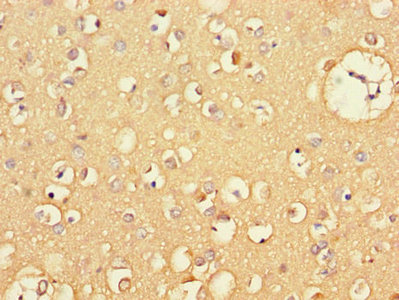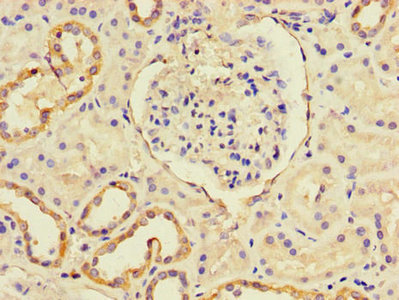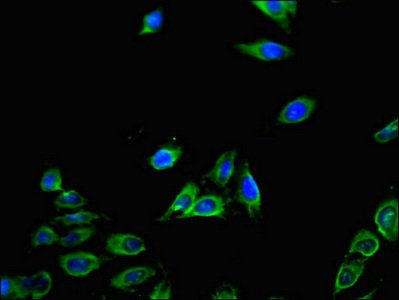-
货号:CSB-PA06119A0Rb
-
规格:¥440
-
促销:
-
图片:
-
Immunohistochemistry of paraffin-embedded human brain tissue using CSB-PA06119A0Rb at dilution of 1:100
-
Immunohistochemistry of paraffin-embedded human kidney tissue using CSB-PA06119A0Rb at dilution of 1:100
-
Immunofluorescent analysis of Hela cells using CSB-PA06119A0Rb at dilution of 1:100 and Alexa Fluor 488-congugated AffiniPure Goat Anti-Rabbit IgG(H+L)
-
-
其他:
产品详情
-
产品名称:Rabbit anti-Homo sapiens (Human) CXCL11 Polyclonal antibody
-
Uniprot No.:O14625
-
基因名:
-
别名:b R1 antibody; b-R1 antibody; Beta-R1 antibody; betaR1 antibody; C-X-C motif chemokine 11 antibody; Chemokine (C-X-C motif) ligand 11 antibody; Chemokine C-X-C motif ligand 11 antibody; CXC11 antibody; CXCL11 antibody; CXL11_HUMAN antibody; H174 antibody; I TAC antibody; I-TAC antibody; Interferon gamma inducible protein 9 antibody; Interferon gamma-inducible protein 9 antibody; Interferon inducible T cell alpha chemoattractant antibody; Interferon-inducible T-cell a chemoattractant I-TAC antibody; Interferon-inducible T-cell alpha chemoattractant antibody; IP 9 antibody; IP-9 antibody; IP9 antibody; ITAC antibody; MGC102770 antibody; SCYB11 antibody; SCYB9B antibody; Small inducible cytokine B11 antibody; Small inducible cytokine subfamily B (Cys-X-Cys) member 11 antibody; Small inducible cytokine subfamily B (Cys-X-Cys) member 9B antibody; Small inducible cytokine subfamily B; member 11 antibody; Small inducible cytokine subfamily B; member 9B antibody; Small-inducible cytokine B11 antibody
-
宿主:Rabbit
-
反应种属:Human
-
免疫原:Recombinant Human C-X-C motif chemokine 11 protein (22-94AA)
-
免疫原种属:Homo sapiens (Human)
-
标记方式:Non-conjugated
本页面中的产品,CXCL11 Antibody (CSB-PA06119A0Rb),的标记方式是Non-conjugated。对于CXCL11 Antibody,我们还提供其他标记。见下表:
-
克隆类型:Polyclonal
-
抗体亚型:IgG
-
纯化方式:>95%, Protein G purified
-
浓度:It differs from different batches. Please contact us to confirm it.
-
保存缓冲液:Preservative: 0.03% Proclin 300
Constituents: 50% Glycerol, 0.01M PBS, PH 7.4 -
产品提供形式:Liquid
-
应用范围:ELISA, IHC, IF
-
推荐稀释比:
Application Recommended Dilution IHC 1:20-1:200 IF 1:50-1:200 -
Protocols:
-
储存条件:Upon receipt, store at -20°C or -80°C. Avoid repeated freeze.
-
货期:Basically, we can dispatch the products out in 1-3 working days after receiving your orders. Delivery time maybe differs from different purchasing way or location, please kindly consult your local distributors for specific delivery time.
引用文献
- The LINC00152/miR-205-5p/CXCL11 axis in hepatocellular carcinoma cancer-associated fibroblasts affects cancer cell phenotypes and tumor growth G Liu,Cellular oncology,2022
- Cancer-associated fibroblast-derived CXCL11 modulates hepatocellular carcinoma cell migration and tumor metastasis through the circUBAP2/miR-4756/IFIT1/3 axis Shuang-Jian Qiu,Cell Death & Disease,2021
相关产品
靶点详情
-
功能:Chemotactic for interleukin-activated T-cells but not unstimulated T-cells, neutrophils or monocytes. Induces calcium release in activated T-cells. Binds to CXCR3. May play an important role in CNS diseases which involve T-cell recruitment. May play a role in skin immune responses.
-
基因功能参考文献:
- V2O5 induction of CXCL8 and CXCL11 chemokines may lead to the appearance and perpetuation of an inflammatory reaction into the dermal tissue. Further studies are required to evaluate dermal integrity and manifestations in subjects occupationally exposed, or living in polluted areas. PMID: 29901202
- BK polyomavirus infection can induce CXCL11 gene expression in kidney transplant patients. PMID: 27759557
- CXCL11 production in cerebrospinal fluid was found in herpes simplex meningitis, but not in herpes simplex encephalitis. PMID: 28693588
- Neuroendocrine-like cells promote the chemotaxis activity of tumor-associated macrophages (TAM) via CXCL10 and CXCL11. PMID: 27034164
- High CXCL11 expression is associated with clear-cell renal cell carcinoma. PMID: 26910919
- this study shows that melanoma peptides vaccination and intratumoral administration of IFNgamma increases production of CXCL11 in patient tumors PMID: 27522581
- Downregulation of CXC chemokine ligand 11 can inhibit tumor angiogenesis, suggesting that anti-CXC chemokine ligand 11 therapy may offer an alternative treatment strategy for TWIST1-positive ovarian cancer PMID: 28488542
- CXCL8/11 may promote the disease progression of osteoarthritis (OA), and may also serve as new therapeutic targets for treatment of OA. PMID: 27567247
- this study shows that oxidative signaling inhibits T lymphocyte chemotaxis to the inflammatory chemokine CXCL11 PMID: 28363904
- The homozygous variant CXCL11 AA genotype (rs6817952) is associated with an increased risk of contact allergy. PMID: 27356947
- In contrast to elevated 1st trimester levels of IP-10 previously found in the maternal serum of women who later developed preeclampsia, this study found lower umbilical cord IP-10 and ITAC plasma levels in near-term gestations with established severe preeclampsia. PMID: 25741937
- CXCL11 levels are mainly increased in patients with non-alcoholic cirrhosis and high portal pressure. Moreover, levels of CXCL11 might predict long-time survival of cirrhotic patients undergoing TIPS. PMID: 26212075
- higher concentration is associated with neutrophils accumulation in the alveolar space of Systemic Lupus Erythematosus patients with pulmonary fibrosis PMID: 26275808
- Developmental expression patterns of chemokines CXCL11, CXCL12 and their receptor CXCR7 in testes PMID: 25810367
- congruent with the concept that inflammation plays a key role in the pathogenesis of LV dysfunction, MIG, IP10 and I-TAC add diagnostic accuracy over and beyond NT-pro BNP. PMID: 26506526
- Resveratrol substantially inhibited the proinflammatory cytokines-induced CXCL11 production while partially blocking nuclear factor-kappaB activation. PMID: 25890876
- Common variants of CXCR3 and its ligands CXCL10 and CXCL11 are associated with vascular permeability of dengue infection in peninsular Malaysia. PMID: 25858769
- Cyclic stretch significantly induced ESC secretion of CXCL8 and CXCL1 and neutrophil chemotaxis. Stretch also increased MMP-1, MMP-2, and MMP-3 activity, activin A secretion, and activity in ESC. PMID: 25605062
- High CXCL11 expression is associated with acute cellular rejection. PMID: 25251331
- These findings functionally integrate K17, hnRNP K, and gene expression along with RSK and CXCR3 signaling in a keratinocyte-autonomous axis and provide a potential basis for their implication in tumorigenesis PMID: 25713416
- The homozygosity for the CXCL9 rs10336 (T), CXCL10 rs3921 (G), and CXCL11 rs4619915 (A) alleles is associated with the higher likelihood of significant liver fibrosis in HIV-infected patients coinfected with hepatitis C virus genotype 1. PMID: 25559603
- The chemokine CXCL11 is produced by mesenchymal stem cells and interacts with CXCR3. PMID: 24526602
- CXCL11 displays antimicrobial activity against E. coli and S. aureus. PMID: 12949249
- The expression of MIF mRNA was compared with VEGF mRNA expression and with mRNA expression of other chemokines related to neo-angiogenesis, such as CXCL12, CXCL11, CXCL8 and CXCR4, in human endometrial cancer tissue and normal endometrium. PMID: 23985752
- CXCL11 was mildlylavage fluid during diffuse alveolar damage, but not during acute rejection or lymphocytic bronchiolitis. Elevated CXCL11 was associated with increased risk of chronic allograft dysfunction. PMID: 24063316
- Our study demonstrates in mixed cryoglobulinemia and hepatitis C vs controls: (i)high serum CXCL9 and CXCL11, significantly associated with the presence of active vasculitis; (ii) a strong relationship between circulating CXCL9 and CXCL11 PMID: 23527708
- CXCR3 ligands CXCL10, CXCL9 and CXCL11 were measured in 245 children with opsoclonus-myoclonus syndrome and 81 controls. PMID: 23600831
- There was no difference in expression of I-TAC between immune thrombocytopenic purpura patients and healthy controls. PMID: 23158864
- Expression of CXCL9, -10, and -11 chemokines and their receptor CXCR3 increases in the aqueous humor of patients with herpetic endotheliitis. PMID: 22367045
- This study demonistrated that CXCL11, absent from normal muscle fibers, were induced in DMD myofibers. and up regulattion on blood vessel endothelium of DMD patients. PMID: 23225384
- Our study first demonstrates higher serum levels of CXCL11 chemokine in patients with mixed cryoglobulinemia than in hepatitis C virus-positive patients, and in particular in the presence of autoimmune thyroiditis. PMID: 22160826
- In chronic graft-vs-host disease, increased levels of the Th1-associated chemokines CXCL9, CXCL10, and CXCL11 led to recruitment of CXCR3+ T cells from the peripheral blood into affected tissues. PMID: 23012327
- Elevated BALF concentrations of CXCL11 in systemic sclerosis patients who do not developed lung fibrosis suggest that determination of CXCL11 in BALF could serve as a prognostic factor for pulmonary function decline. PMID: 22691213
- CXCL10, CXCL11, CXCL12 and CXCL13 chemokines are biomarkers in serum and cerebrospinal fluid in patients with tick borne encephalitis PMID: 22008312
- A strong relationship between circulating IFN-gamma and CXCL11 is shown, supporting the role of a T helper (Th)1 cell immune response in the pathogenesis of mixed cryoglobulinemia and hepatitis C. PMID: 21724697
- circulating CXCL11, together with CXCL10, is increased in patients with thyroiditis and hypothyroidism, and is related to CXCL10 levels. PMID: 22168752
- Elevated plasma levels of interferon-gamma and Cys-X-Cys chemokine receptor 3-binding chemokine CXCL11 are present in patients with thoracic aortic aneurysms. PMID: 21962843
- CXCR3 ligands, CXCL9,10,11, are differentially expressed during chronic liver diseases across different disease stages and aetiologies. PMID: 21645215
- We first show that circulating CXCL9 and CXCL11 are increased in patients with thyroiditis and hypothyroidism and are related to each other. PMID: 21470996
- involved in microbial-induced intestinal inflammation and Th17 cell development in ulcerative colitis PMID: 21438871
- A potent dose-dependent inhibition by PPARalpha-agonists was observed on the cytokines-stimulated secretion of CXCL11 in Graves disease and in primary thyrroid culture. PMID: 20810571
- The expression and function of CXCR3 and CXCR7 receptors in cervical carcinoma, rhabdomyosarcoma and glioblastoma cell lines, was evaluated. PMID: 20529825
- Studies indicate that CXCR7 is an interceptor for CXCL12 and CXCL11. PMID: 20036838
- TNFSF14 enhanced IFN-gamma-induced secretion of CXCL10 and CXCL11 from human gingival fibroblasts. PMID: 19939453
- Studies indicate that I-TAC-targeted intervening strategies would have potential application for the alleviation of acute transplant rejection. PMID: 19875106
- I-TAC is a highly potent chemoattractant of normal blood CD4 and CD8 T cell transendothelial migration and a major mediator of blood memory T lymphocyte migration to inflammation. PMID: 12055261
- The IFN-gamma-inducible T cell alpha-chemoattractant was induced in human brain microvascular endothelial cells and astrocytes only after inflammatory stimuli. PMID: 12162873
- These data suggest that IFN-beta acts through PI3K to enhance the transactivation competence of NF-kappa B complexes through phosphorylation of p65 within the TAD of beta-R1. PMID: 12169689
- Levels of ITAC/CXCL11 were found elevated in patients with severe transplantation coronary artery disease (TCAD) compared with long-term survivors of transplantation without TCAD and healthy volunteers who had not undergone transplantation PMID: 12695288
- increased calpain activity in undifferentiated keratinocytes. inhibited calpain activity in fibroblasts. redifferentiated basal keratinocytes limit fibroblast repopulation of dermis of healed wounds while promoting re-epithelialization. PMID: 12787142
显示更多
收起更多
-
亚细胞定位:Secreted.
-
蛋白家族:Intercrine alpha (chemokine CxC) family
-
组织特异性:High levels in peripheral blood leukocytes, pancreas and liver astrocytes. Moderate levels in thymus, spleen and lung. Low levels in placenta, prostate and small intestine. Also found in epidermal basal layer keratinocytes in skin disorders.
-
数据库链接:
HGNC: 10638
OMIM: 604852
KEGG: hsa:6373
STRING: 9606.ENSP00000306884
UniGene: Hs.632592
Most popular with customers
-
-
YWHAB Recombinant Monoclonal Antibody
Applications: ELISA, WB, IF, FC
Species Reactivity: Human, Mouse, Rat
-
Phospho-YAP1 (S127) Recombinant Monoclonal Antibody
Applications: ELISA, WB, IHC
Species Reactivity: Human
-
-
-
-
-
























